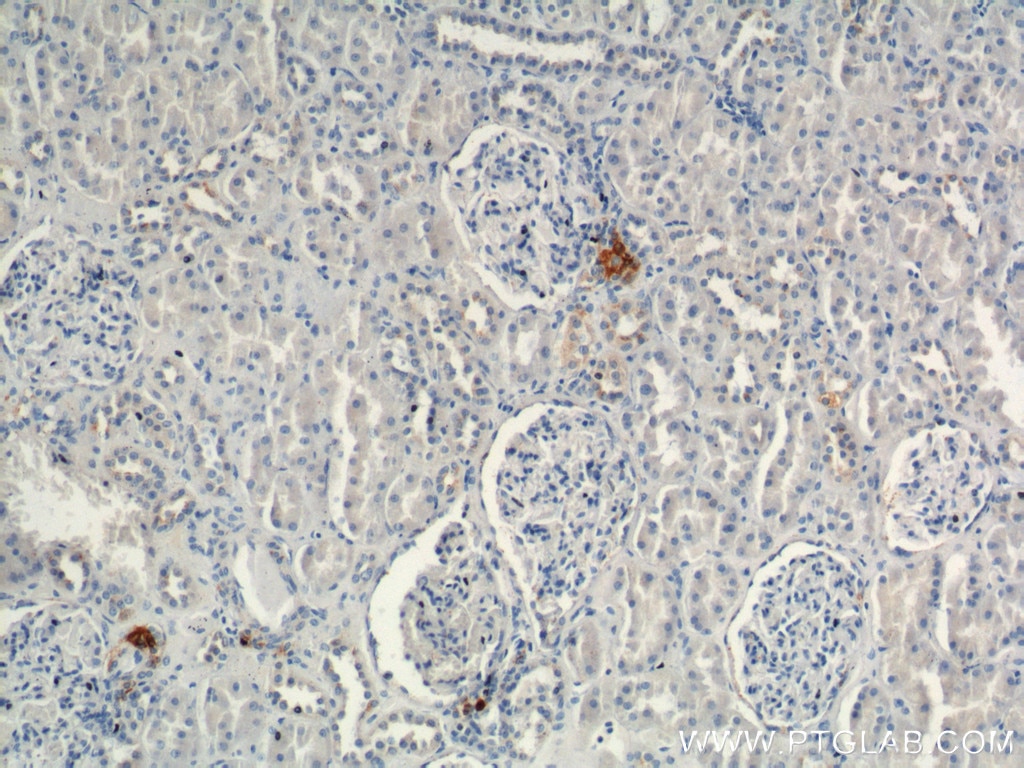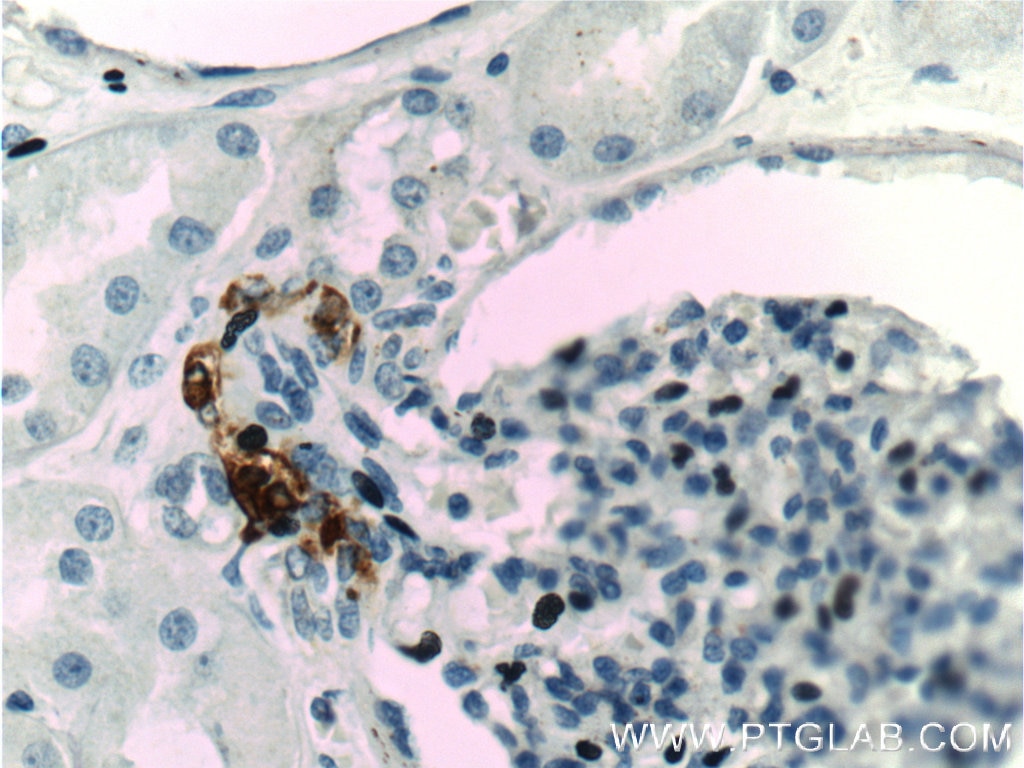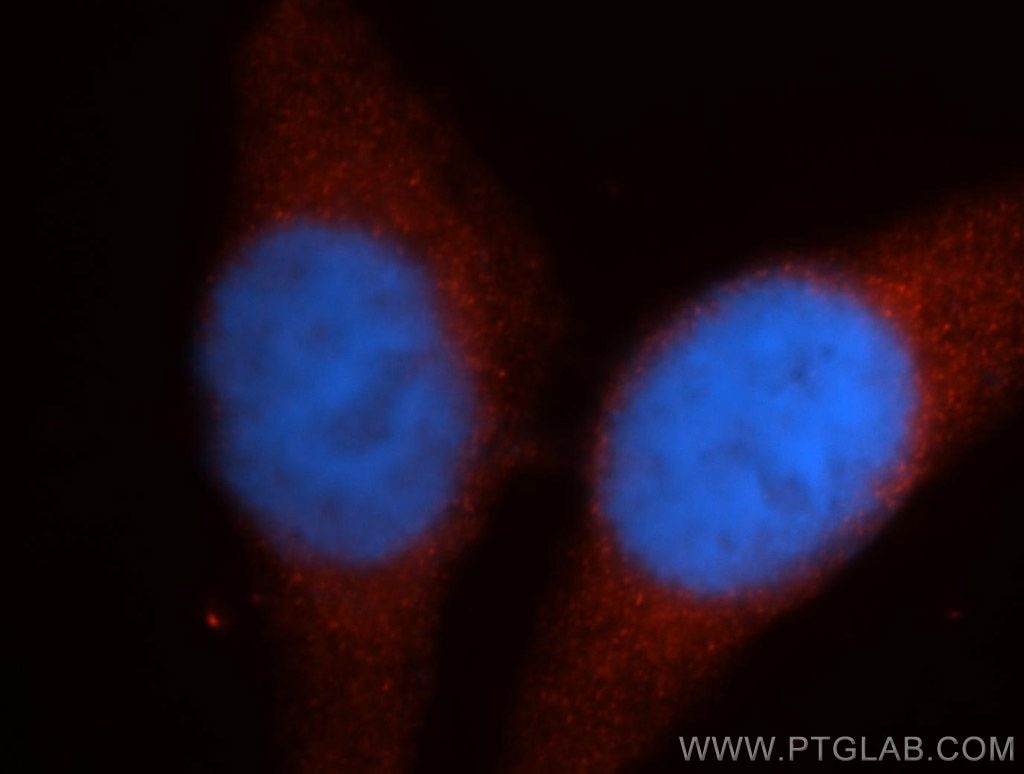Anticorps Polyclonal de lapin anti-Renin
Renin Polyclonal Antibody for WB, IF, IHC, ELISA
Hôte / Isotype
Lapin / IgG
Réactivité testée
Humain, rat, souris
Applications
WB, IHC, IF/ICC, ELISA
Conjugaison
Non conjugué
N° de cat : 14291-1-AP
Synonymes
Galerie de données de validation
Applications testées
| Résultats positifs en WB | cellules K-562, cellules HepG2 |
| Résultats positifs en IHC | tissu rénal humain, tissu de gliome humain, tissu rénal de souris il est suggéré de démasquer l'antigène avec un tampon de TE buffer pH 9.0; (*) À défaut, 'le démasquage de l'antigène peut être 'effectué avec un tampon citrate pH 6,0. |
| Résultats positifs en IF/ICC | cellules HepG2 |
Dilution recommandée
| Application | Dilution |
|---|---|
| Western Blot (WB) | WB : 1:500-1:2000 |
| Immunohistochimie (IHC) | IHC : 1:400-1:1600 |
| Immunofluorescence (IF)/ICC | IF/ICC : 1:20-1:200 |
| It is recommended that this reagent should be titrated in each testing system to obtain optimal results. | |
| Sample-dependent, check data in validation data gallery | |
Applications publiées
| WB | See 11 publications below |
| IHC | See 11 publications below |
| IF | See 4 publications below |
Informations sur le produit
14291-1-AP cible Renin dans les applications de WB, IHC, IF/ICC, ELISA et montre une réactivité avec des échantillons Humain, rat, souris
| Réactivité | Humain, rat, souris |
| Réactivité citée | rat, Humain, souris |
| Hôte / Isotype | Lapin / IgG |
| Clonalité | Polyclonal |
| Type | Anticorps |
| Immunogène | Renin Protéine recombinante Ag5612 |
| Nom complet | renin |
| Masse moléculaire calculée | 45 kDa |
| Poids moléculaire observé | 45 kDa |
| Numéro d’acquisition GenBank | BC047752 |
| Symbole du gène | REN |
| Identification du gène (NCBI) | 5972 |
| Conjugaison | Non conjugué |
| Forme | Liquide |
| Méthode de purification | Purification par affinité contre l'antigène |
| Tampon de stockage | PBS avec azoture de sodium à 0,02 % et glycérol à 50 % pH 7,3 |
| Conditions de stockage | Stocker à -20°C. Stable pendant un an après l'expédition. L'aliquotage n'est pas nécessaire pour le stockage à -20oC Les 20ul contiennent 0,1% de BSA. |
Informations générales
REN(Renin) is also named as angiotensinogenase and belongs to the peptidase A1 family. It is a highly specific endopeptidase, whose only known function is to generate angiotensin I from angiotensinogen in the plasma, initiating a cascade of reactions that produce an elevation of blood pressure and increased sodium retention by the kidney. Human prorenin and renin are synthesized in juxtaglomerular cells and it locates in the juxtaglomerular cells and afferent arteriole as cytoplasmic granules (PMID:19664745, 9453303). REN has 2 isoforms produced by alternative splicing with the molecular weight of 45-47kDa. The mature REN can be detected as 38-42 kDa due to the cleavage of signal peptide and propeptide, and also detected as 55-60 kDa with variable degrees of glycosylation (PMID: 20966072, 15226276).Defects in REN are a cause of renal tubular dysgenesis (RTD) and familial juvenile hyperuricemic nephropathy type 2 (HNFJ2).
Protocole
| Product Specific Protocols | |
|---|---|
| WB protocol for Renin antibody 14291-1-AP | Download protocol |
| IHC protocol for Renin antibody 14291-1-AP | Download protocol |
| IF protocol for Renin antibody 14291-1-AP | Download protocol |
| Standard Protocols | |
|---|---|
| Click here to view our Standard Protocols |
Publications
| Species | Application | Title |
|---|---|---|
Br J Pharmacol Novel inhibitors of the cellular RAS components, Poricoic acids, target Smad3 phosphorylation and Wnt/β-catenin pathway against renal fibrosis. | ||
Plant Physiol Lysine malonylation of DgnsLIPID TRANSFER PROTEIN1 at the K81 site improves cold resistance in chrysanthemum | ||
Antioxid Redox Signal Silencing of central (Pro)renin receptor ameliorates salt-induced renal injury in CKD. | ||
J Agric Food Chem Novel RAS Inhibitors Poricoic Acid ZG and Poricoic Acid ZH Attenuate Renal Fibrosis via a Wnt/β-Catenin Pathway and Targeted Phosphorylation of smad3 Signaling. | ||
Int J Mol Sci Exogenous H2S Attenuates Hypertension by Regulating Renin Exocytosis under Hyperglycaemic and Hyperlipidaemic Conditions |














